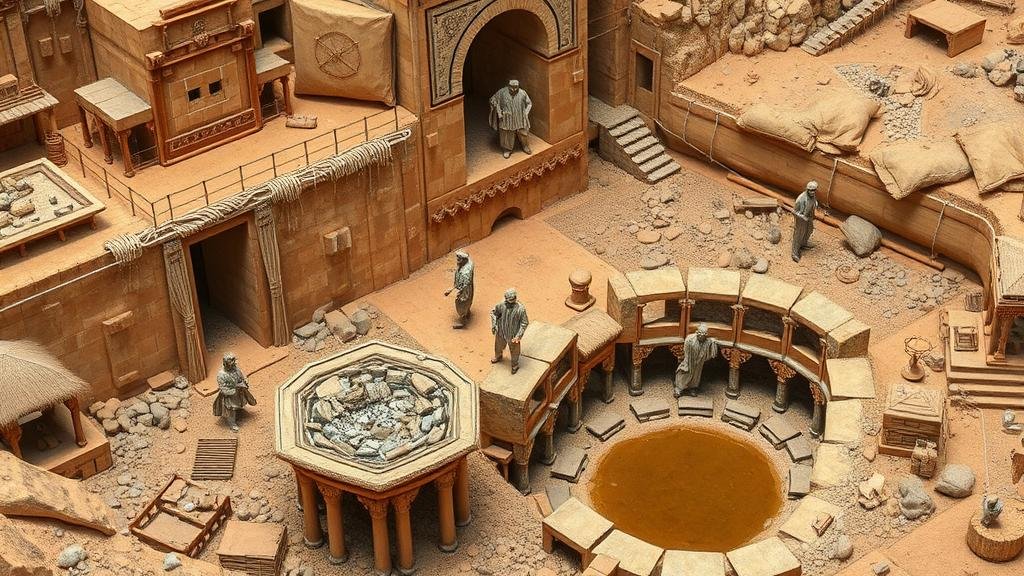Mining in Mesopotamia: The Role of Copper and Bitumen Extraction
Mining in Mesopotamia: The Role of Copper and Bitumen Extraction
Mesopotamia, often referred to as the cradle of civilization, played a pivotal role in the development of human society through its advancements in agriculture, writing, and trade. Among its contributions to technology and economy was mining, particularly the extraction of copper and bitumen. This article explores the significance of these resources, their extraction methods, and their impacts on Mesopotamian society.
The Importance of Copper
Copper, one of the first metals utilized by humans, was integral to the development of tools, weapons, and art in Mesopotamia. region possessed rich copper deposits, particularly in the mountains of Anatolia and the Zagros. These deposits provided a steady supply of copper and positioned Mesopotamia as a key player in the trade of metal goods.
Copper Extraction Techniques
The process of copper extraction in ancient Mesopotamia involved several steps, largely primitive by modern standards but effective for the time. Early methods included:
- Mining in open pits and shafts to access ore veins.
- Crushing and grinding the mined ore to extract copper minerals.
- Smelting, where the ore was heated in furnaces to separate the metal from impurities.
Archaeological evidence indicates that early smelting techniques were developed around 4500 BCE, and by 3000 BCE, metallurgy had significantly advanced, enabling the production of bronze through the alloying of copper and tin.
Bitumen: A Unique Resource
Bitumen, a naturally occurring sticky black substance, was another critical resource in Mesopotamia, primarily extracted from the regions seepage sites. It served multiple purposes, from construction to medicinal uses. The primary sources included deposits found in the vicinity of the Euphrates River and in regions like Asphalt Lake near modern-day Babil.
Bitumen was particularly valued for its waterproofing properties and was used in various applications:
- Construction material for roads, buildings, and ziggurats, enhancing stability and longevity.
- Sealing boats to make them more durable and resistant to water damage.
- As a binder for clay tablets and other artifacts, contributing to the preservation of writing.
The Economic Impact of Mining Activities
The extraction of copper and bitumen contributed significantly to the economy of Mesopotamian city-states. The mining industry created jobs and stimulated trade, both locally and with neighboring regions. Cities like Uruk and Ur became commercial hubs where processed goods were exchanged, bolstering their economic power.
Trade Networks
Mesopotamias strategic location facilitated trade routes that connected its cities with ancient Egypt, the Indus Valley, and Anatolia. Copper and bitumen were among the key commodities traded:
- Mesopotamian copper tools were exported for their superior quality.
- Bitumen was traded for luxury items, textiles, and foodstuffs from surrounding areas.
These exchanges not only enriched Mesopotamian cities but also fostered cultural interactions and technological exchanges between civilizations, influencing broader historical developments.
Challenges and Innovations
While mining brought prosperity, it also presented challenges. Resource depletion and environmental degradation became concerns as extraction intensified. To address these issues, Mesopotamian societies started developing more sophisticated mining techniques and regulations aimed at sustainable resource management, thereby laying a foundation for future practices in mining.
Conclusion
The mining of copper and bitumen was crucial to the development of Mesopotamian civilization. It advanced technological capabilities, stimulated trade, and contributed to the economy while shaping the societal structure of the time. Understanding these ancient practices provides insights into how Mesopotamian societies adapted to their environment and resources, influencing subsequent civilizations.
In summary, the legacy of copper and bitumen extraction in Mesopotamia illustrates the importance of natural resources in shaping human history, a lesson still relevant in todays discussions on resource management and sustainable practices.


